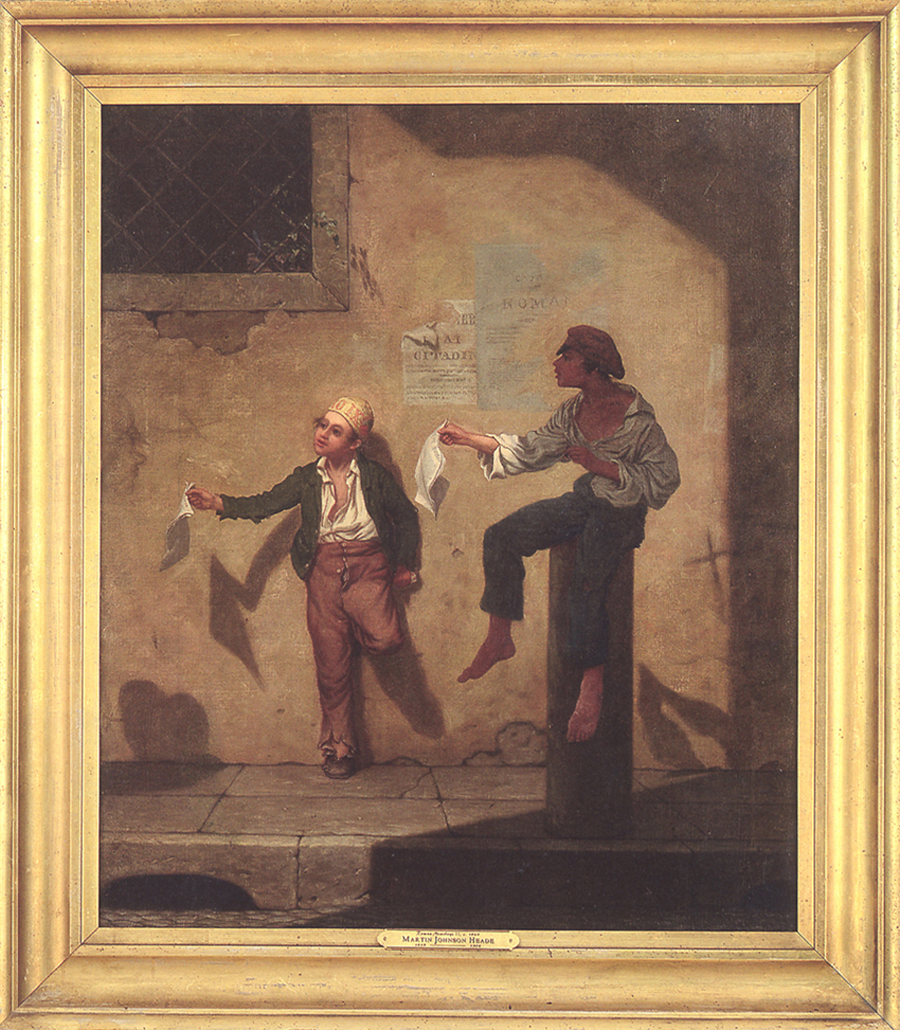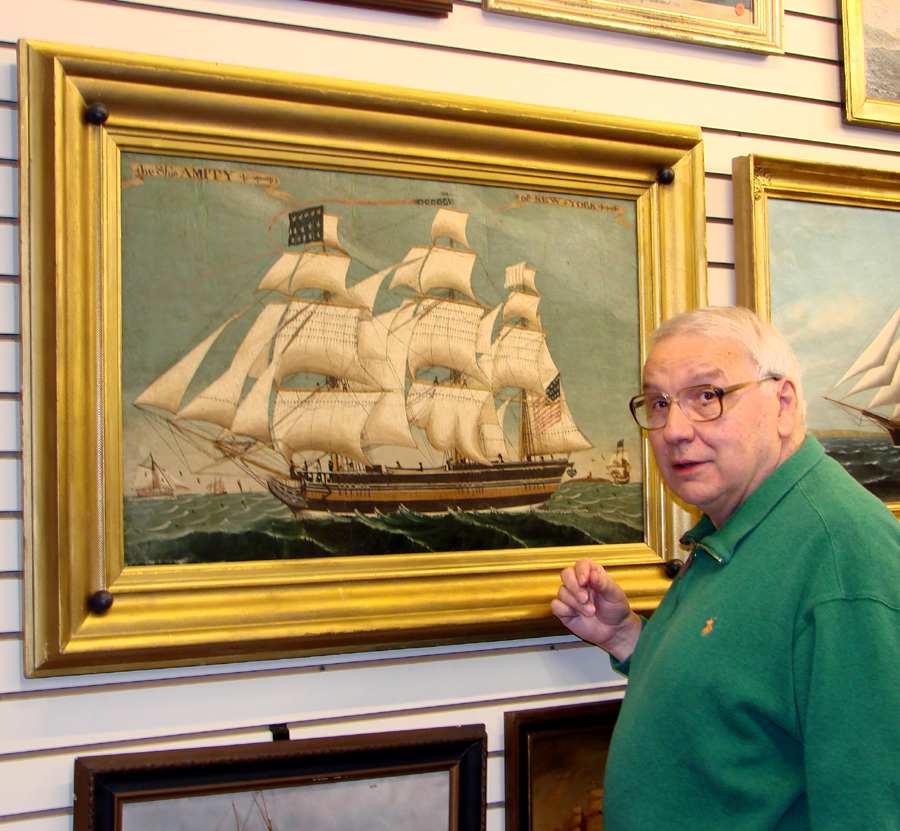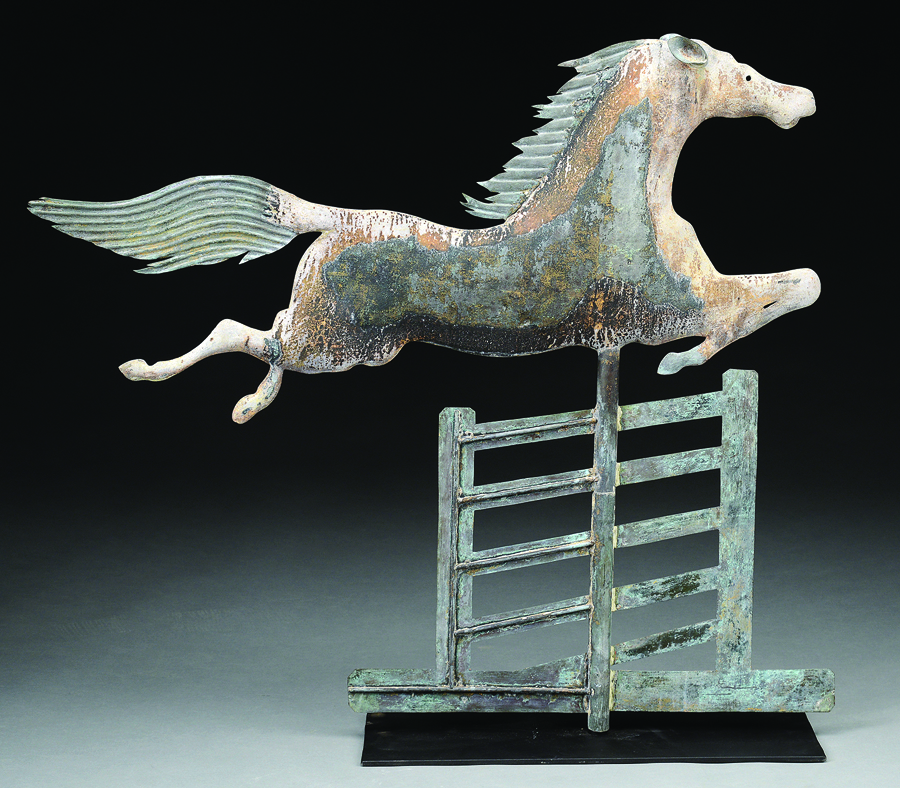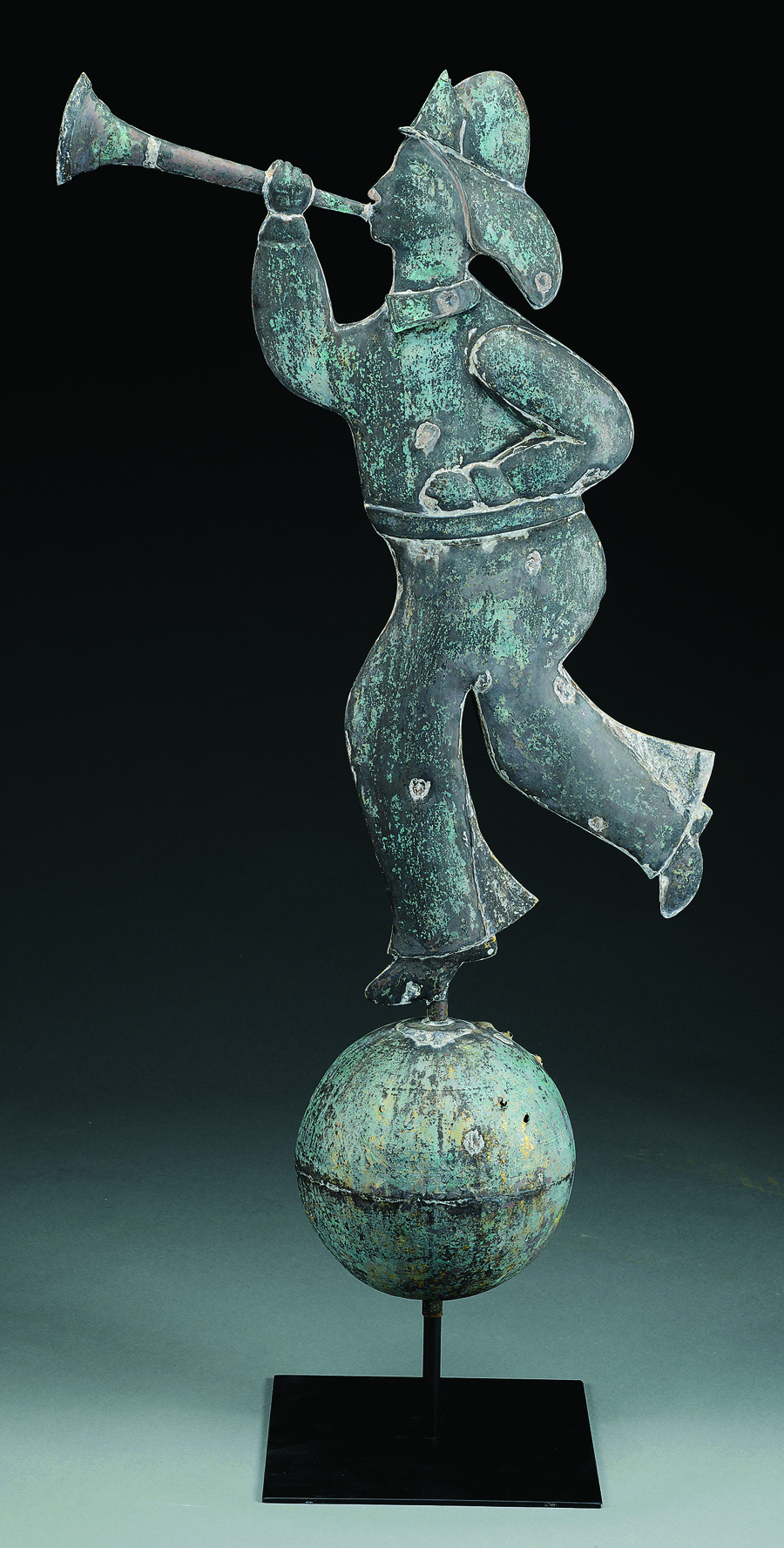
Jim Julia shows off his favorite item in the auction, the powder horn used at the Battle of Concord Bridge, the first battle of the American Revolution. Prior to selling the lot, Julia provided a good history lesson about the battle for the audience.
Review And On-Site Photos By Rick Russack,
Catalog Photos Courtesy Of Julia’s
FAIRFIELD, MAINE — Jim Julia’s three-day sale of fine art, Americana, antiques and Asian arts February 3–5 grossed $3.2 million. Paintings performed well, and the most expensive item of the sale was a genre painting by Martin Johnson Heade, (American, 1819–1904), which sold for $189,600. Another painting brought a six-figure price, as did one of several fine weathervanes. The first day of the sale was devoted to fine art, the second to Americana and decorative arts, while the third day saw a wide variety of Asian arts cross the block. In all, more than 1,300 lots were sold. According to Julia’s, audience participation was strong, with more than 734 registered bidders, of whom 130 were new to Julia’s, more than 5,500 registered online bidders representing 54 countries and about a dozen phone lines were in use. The salesroom was full as the sale got underway.
Fine arts were sold on day one and included the two paintings that sold for six figures and one that did not miss by much. Leading the group, and the entire sale, was Heade’s “Roman Newsboys II,” that was one of only two genre paintings by Heade; the other being an earlier version of the same painting. Done in 1849 when Heade was in Rome, the painting at Julia’s depicts two newsboys and is listed in Ted Stebbins’ definitive catalogue raisonné on Heade.
The second six-figure painting was “Searching The Mountains” by Howard Terpning (American, b 1927) which brought $124,425. It was a colorful work, depicting two mountain men with pack horses; one rider is looking out over the mountains. The painting is signed and dated with a signed inscription on the reverse, “Best regards to my friend Norm Flayderman.” Terpning was a member of the Cowboy Artists of America and known for scenes like this one and of native Americans. Coming in at just under six figures was “Botanic Garden” by Hans Hofmann (American, 1880–1966). It was an abstract painting of flowers, inscribed on the back “To Dave Passell/Our Love/Hans & Renate,” and it went out at $94,800.

Tony Greist, an expert on Asian arts and artifacts at Julia’s, liked this 1766 Queen Anne tall case clock made by Jeduthan Baldwin. The sale also included an archive of research material on the clockmaker.
A bronze sculpture attributed to Edvard Munch (Norwegian, 1863–1944) finished at $17,775. The bronze was mounted on slate and one edge of the slate is signed E. Munch, “Sostrene.” The subject of this bronze is thought to be a depiction of the Meissner sisters. The sisters were sitters for several of Munch’s prints and paintings, including a color print titled “Sostrene Meissner 1907–1908.” Very little is known about Munch’s sculpture, especially his bronze work. There has been little research or academic study. Upon Munch’s death the contents of his studio and the collection of his works were given to the city of Oslo, Norway, where a museum was founded to house the collection. Included were 100 paintings, 1,500 watercolors and drawings, 18,000 prints and six sculptures, along with 92 sketch books and letters.
This sculpture was purchased at a small estate auction in New York. The bronze, on its slate base, had been permanently affixed to the wood pedestal. The new owner decided to separate it from its base to build a more appropriate presentation, and upon removing the bronze from its base, the slate was found to have the signature and title etched on the side where it had been hidden from view ever since it had been glued onto the pedestal.
Several works by members of the Rockport Art Association also sold on the first day. Leading the group was a Western scene by Aldro Thompson Hibbard (1886–1972) finishing at $17,775, while a Cape Ann harbor view by Hibbard earned $4,740. There were three paintings by Emil Gruppe (1896–1978). His “Gloucester Morning” brought the highest price of the three, finishing at $11,850. A winter scene by the same artist earned $10,665, and “Rocky Cove,” a seascape, reached $5,332. Other American paintings did well. Two paintings by Grant Wood (1891–1942) each sold for $9,480. Each was titled “Sorrento, 1924.” A Maine coastal scene by Walter E. Schofield (1866–1944) reached $26,662, and “Arranging the Flowers” by Abbott Fuller Graves (1859–1936) finished at $13,627.

The top selling lot of the three days was a rare genre scene by Martin Johnson Heade, (American, 1819–1904). Heade is believed to have only painted two genre scenes and this was one. Titled “Roman Newsboys II,” it was painted in 1849, while Heade was in Italy. It brought $189,600.
The second day started off with a collection of Revolutionary War arms and memorabilia. The third lot sold was a silver Revolutionary War eagle-pommel officer’s sword that had belonged to Captain William Storer. It was made and signed by Samuel Drowne, Piscataqua (Portsmouth, N.H.). Drowne was a silversmith in Portsmouth and an ardent patriot who participated in a battle that many consider to have actually been the first battle of the revolution. In December 1744, there was a rumor that the British intended to secure Fort William and Mary in Portsmouth harbor. Paul Revere rode to Portsmouth to alert residents to the expected move. Portsmouth citizens were concerned that the gun powder in the fort did not fall into British hands. Several hundred armed men, led by Captain Thomas Pickering, Drowne’s brother-in-law, raided the fort and 400 barrels of powder were moved to a safer place. Drowne was politically active throughout the war.
The sword, doubling its estimate, sold for $24,292 to Don Kollman, a Portsmouth resident and collector of early firearms and American furniture. Kollman told Antiques and The Arts Weekly, “It’s going home.” It is worth mentioning that Julia’s catalog descriptions are unusually comprehensive and informative; the description of this lot includes three photos and two pages of text and historical background.
The sale included several early powder horns with connections to early battles and other military accoutrements. One of the powder horns was particularly important, having been carried by a minuteman in the battle of Concord Bridge, April 19, 1775, the first battle of the Revolutionary War. It was owned by Oliver Buttrick, who along with six other members of the Buttrick family, fought that day. The powder horn is dated October 1774 and has Oliver Buttrick’s name on it. The date is significant. It was on October 24, 1774, that the recently formed Massachusetts Provincial Congress authorized the procurement of arms.
Jim Julia believes that this powder horn is the only one known to have been used in that battle that has ever been offered for sale and is one of the few existing objects that can be directly associated with the events of that day. It sold well over its estimate, ending up at $88,875. The catalog description is four pages long and includes six photos. Julia gave the audience a history lesson on the early days of the war as he was getting ready to sell the powder horn.

“Searching The Mountains,” by well-known cowboy artist Howard Terpning (American, b 1927), was one of the top-selling paintings on day one of the sale. It finished within estimates at $124,425.
Early flags also did well. Creating the most interest was a 12-star Confederate flag, circa 1861. The flag was hand-sewn, made from red, white and blue cotton, and may have been intended to be an 11-star flag with the additional star perhaps representing Missouri, a border state which was considering joining the Confederacy. It achieved $10,665. A 31-star flag, issued when California was admitted as a state in 1851, sold for $6,221. Thirty-one star flags were in use until 1858 when Minnesota was admitted.
Tony Annese, a folk art collector from New Jersey, paid $25,477 for an unsigned oil on paperboard portrait of the ship Amity, circa 1816–20. The ship was owned by the Black Ball Line and this is signified by four black balls in the corners of the carved gilt frame. Annese said that he was interested in the painting because of its local connection. On April 24, 1824, the ship ran aground in Manasquan, N.J. The passengers and crew were rescued but some of the cargo was lost. Manasquan is close to the painting’s new home. Another ship portrait in the sale, Solon Francis Montecello Badger’s (American, 1873–1919) schooner Bessie C. Beach in a choppy sea ended up at $9,480. “Gloucester Fishermen on the Rocks,” by Antonio Jacobsen (American, 1850–1921), went for $8,295, well over its estimate. A whaling scene attributed to John William Huggins, (British, 1781–1845) seemed low, going out at $2,962. It depicted the crew preparing to harpoon a whale.
Most of the American furniture lots sold, although under estimates. A cherry Queen Anne tray top tea table, mid-Eighteenth Century, Connecticut, finished at $14,220, about half its low estimate. An assembled set of six walnut Queen Anne compass-seat side chairs, with vase-shaped splats, mid-Eighteenth Century Massachusetts, realized $9,480, also about half the low estimate, and a Chippendale Newport mahogany corner chair, late Eighteenth Century, with two carved scrolled splats, reached $4,740.

New Jersey folk art collector Tony Annese bought this ship portrait because the ship had run aground in 1824 near his home. The painting was unsigned and depicted the ship Amity owned by the Black Ball Line.
Clocks did a little better. Made by Thomas Harland, Norwich, Conn., circa 1780–90, a Chippendale tall case clock earned $13,035. It had an arched fret-work bonnet with three turned finials. Repairs may have held back the price. A Queen Anne cherry tall case clock by a Massachusetts maker, Jeduthan Baldwin, with a brass dial engraved “Jedun. Baldwin, Esqr. Brookfield, 1776,” fetched $9,480. The clock was accompanied by an archive of research material and original documents related to Baldwin, which sold for $5,925, far exceeding the $600 estimate. A Simon Willard Federal period tall case clock, Roxbury, Mass., went out at $26,070. Signed on the face, it had Roman and Arabic numerals, a second hand, a calendar dial and a moon-phase dial decorated with a ship and landscape painting.
Tom Brown, a dealer from Pittsford, Vt., and his fiancé, Julianne McCarthy, a part-time dealer and real estate broker, consigned an elaborately carved rococo revival dining room set attributed to Alexander Roux. Julianne was one of the younger people in the gallery and Antiques and The Arts Weekly started a conversation with the couple, who are expecting a baby boy. Though the dining set sold below estimate at $8,887, the couple was enjoying the sale.
Some exceptional weathervanes led the folk art category. A large steeple-chase horse jumping a gate fetched $112,575. Made by A.L. Jewell, circa 1860–65, it measured 31½ by 36 inches, with a fine original verdigris surface. Not far behind, selling for $94,800, was a monumental full-bodied fireman weathervane, 59½ inches tall with the ball, and 28 inches wide. It was probably made by the Mott Company of Chicago and had originally been found in Illinois. It had vestiges of the original surface after several coats of silver roofing paint were removed. An oversized cow weathervane with a cast head, 41 inches long, possibly made by Harris & Sons circa 1880, earned $13,627.

The top weathervane of the sale was this large steeplechase horse jumping a gate. Made by the A.L Jewell Co. circa 1860–65, it was 36 inches long, had untouched original surface and exceeded estimate at $112,575.
An unusual paint-decorated box had a bust portrait of a gentleman in a black coat on its top. Grain painted all over, it was attributed to Royall Brewster Smith, an itinerant artist working in southern Maine. About three dozen portraits are known by the artist, all in southern Maine. The box finished at $5,925. A portrait of a child with a lamb and canary, signed Robert Street (American, 1796–1865), more than doubled its estimate, reaching $13,035. Also selling well over estimate was an early Nineteenth Century painted fire bucket that fetched $17,182. Decorated with a painting of a burning building, a water pumper and a fireman, it was for the Citizen’s Fire Co. A brightly painted Parcheesi board, with a Canadian maker’s label, achieved $2,962.
The second day also included some less common items, such as a 1925 Harley Davidson “FE” motorcycle that went out at $18,367, well over the high estimate of $8,000. This model was advertised at the time as incorporating “27 big improvements,” and it had been restored with green paint, red stripes and a large leather saddle seat. Only 1,750 “FE” models were made, and the catalog stated that running condition was unknown.

Originally found in Illinois, and probably made by the Mott Company of Chicago, this fireman weathervane stood 52 inches tall. It had traces of the original surface that appeared after several coats of silver roofing paint had been removed. It fetched $94,800.
An extensive catalog entry describes a rare block of six “right-side up” 24-cent Flying Jenny stamps, published by the US Postal Service in 2013 to commemorate the inadvertent release of the famous inverted Jenny stamps in 1918. The 2013 post office intentionally printed 100 blocks of the “right-side-up” stamps as part of a print run of 2.2 million blocks of six showing the “inverted” Jenny. This block of six, with the intentionally produced error, made a final price of $59,250. It’s believed that only 77 blocks of the 2013 right-side-up Jennys were released to the public and that explains the price. Only one sheet of a hundred of the 1918 inverted Jenny stamp, considered to be the rarest US stamp, reached the public and a block of four from that sheet was sold in 2005 for $2.7 million dollars.
Also in the category of uncommon items were two early European iron and brass irons. One, made in Austria, late Eighteenth–early Nineteenth Century, with a turned oak handle on dolphin-like supports, reached $3,555. The second one, made in Scotland and dating to the first half of the Nineteenth Century, realized $2,370.
Carved jades, Oriental porcelains and other Asian items crossed the block in the last session. Leading the day was a Seventeenth Century carved rhinoceros horn “scholars landscape” cup, which sold for $56,287, well over the estimate. Its carvings depicted several elderly men at various pursuits: painting, reading, drinking tea, etc, under a canopy of pine against a mountainous backdrop. Rhinoceros horn objects are subject to restrictions imposed by the presidential executive order of February 2014, regarding the commercial marketing of elephant ivory and certain other items made with parts of endangered species. The catalog entry for this rhino horn cup states that the item is certifiable under the regulations spelled out by the executive order. A page and a half in the front of the catalog describes Julia’s position on this subject.
Several Asian porcelain items also sold over their estimates. A Ge ware foliate brush washer sold for $16,590. The flared sides folded into ten floral petals, covered overall with an opaque glaze with wide dark crackles and dense brown crackles. Certain Chinese artists preferred brush washers of Ge porcelain over all others. A Ge-type tripod censer, covered overall in a thick opaque glaze, with iron colored crackles, fetched $12,442. A Guan-type Longchuan arrowhead vase, with a pair of tube handles around the rim and a lustrous gray-green crackled glaze, went well over its estimate, finishing at $8,295. Another Guan-type Longchuan piece, a lobed vase with a crackled grayish-blue glaze, earned $14,220. A Ming dynasty double gourd porcelain vase was decorated around the exterior with a scene of dragons and phoenix in flight, surrounded by stylized clouds above a ring of waves. The underside had a six-character Jiajing mark in underglaze blue: it realized $9,480.

Tom Brown and his fiancé, Julianne McCarthy, consigned the heavily carved dining room set attributed to Alexander Roux that brought $8,887.
Many of the jade lots were from the collection of Dr Helga Wall-Apelt, most of which Julia’s sold last year. Some did well and some did not meet the reserves. A mottled yellow jade carving of a fish cataloged as Ming dynasty or later finished at $24,885. From the same collection came a very large pair of Ming dynasty cast iron Buddhist lions. The lions were 45 inches tall and the catalog noted that Chinese iron objects of this size are quite rare as they were often melted down as the demand for metal increased. Unsold items, such as some of the jade pieces, are available after the sale. The online auction results posted after the sale clearly indicate which items failed to sell and include links for anyone wishing to make an offer.
After the sale, Jim Julia told Antiques and The Arts Weekly, “In general, I was pleased with the sale. It’s a different day now and the market has a different price structure. Great rarities, like some of the weathervanes, do well, while some average material struggles. It’s definitely the time to buy early American furniture and we had a couple at this sale buying good pieces as wedding presents for their soon-to-be married daughter.” Julia said that it is necessary to discuss the current state of the market realistically with prospective consignors. Not only have antiques and firearms declined but so have blue-chip stocks. “When we present that realistically, and with a positive attitude, consignors understand.”
While discussing items that failed to sell, he noted, “In some categories, buyers’ tastes and degree of sophistication have changed and that may make it more difficult to sell certain items.” Julia’s is one of the few auction houses to guarantee their catalog descriptions. “Buyers have 45 days from the date of the auction to return any item that is not properly described and that policy is stated as item #1 in our conditions of sale. We have to make prospective buyers feel comfortable and confident bidding at our sales. That’s part of the reason that our descriptions are so comprehensive. Buyers have to know that we know what we’re selling and that we’ve taken the time to research items and their backgrounds.”
All prices includes the buyer’s premium. For information, www.jamesdjulia.com or 207-453-7125.

